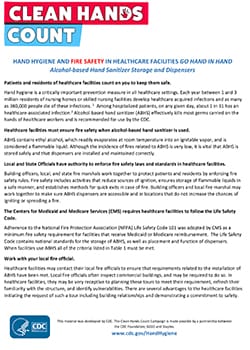Fire Safety and Alcohol-Based Hand Sanitizer (ABHS)
Hand Hygiene and Fire Safety in Healthcare Facilities Go Hand in Hand
Hand hygiene is a critically important prevention measure in all healthcare settings. Each year between 1 and 3 million residents of nursing homes or skilled nursing facilities develop healthcare acquired infections and as many as 380,000 people die of these infections.1 Among hospitalized patients, on any given day, about 1 in 31 has an healthcare-associated infection.2 Alcohol-based hand sanitizer (ABHS) effectively kills most germs carried on the hands of healthcare workers and is recommended for use by the CDC.
ABHS contains ethyl alcohol, which readily evaporates at room temperature into an ignitable vapor, and is considered a flammable liquid. Although the incidence of fires related to ABHS is very low, it is vital that ABHS is stored safely and that bulk dispensers are installed and maintained correctly.
Building officers, local, and state fire marshals work together to protect patients and residents by enforcing fire safety rules.
Fire safety includes activities that
- reduce sources of ignition,
- ensures storage of flammable liquids in a safe manner, and
- establishes methods for quick exits in case of fire.
Building officers and local fire marshal may work together to make sure ABHS dispensers are accessible and in locations that do not increase the chances of igniting or spreading a fire.
Adherence to the National Fire Protection Association (NFPA) Life Safety Code 101 was adopted by CMS as a minimum fire safety requirement for facilities that receive Medicaid or Medicare reimbursement. The Life Safety Code contains national standards for the storage of ABHS, as well as placement and function of dispensers. When facilities use ABHS all of the criteria listed in Table 1 must be met.
The Centers for Medicaid and Medicare Services (CMS) requires healthcare facilities to follow the Life Safety Code.
Healthcare facilities may contact their local fire officials to ensure that requirements related to the installation of ABHS have been met. Local fire officials often inspect commercial buildings, and may be required to do so. In healthcare facilities, they may be very receptive to planning these tours to meet their requirement, refresh their familiarity with the structure, and identify vulnerabilities. There are several advantages to the healthcare facilities initiating the request of such a tour including building relationships and demonstrating a commitment to safety.
| Criteria | Requirement |
|---|---|
| Hand rub solution | Must not exceed 95% alcohol content by volume. (The Centers for Disease Control and Prevention recommends that ABHS contain at least 60% alcohol.) |
| Maximum dispenser fluid capacity | 1.2 liters (41 ounces, 0.32 gal) for dispensers in rooms, corridors, and areas open to corridors. 2.0 liters (67 ounces, 0.53 gal) for dispensers in suites of rooms separated from corridors. |
| Maximum quantity in aerosol containers | 18 oz., limited to Level 1 aerosols as defined by NPFA 30 B. |
| Maximum quantity of ABHS allowed in-use (i.e., in dispensers) | Ten gallons (37.8 L) in-use outside of a storage cabinet within a single smoke compartment. (Smoke compartment: A space within a building enclosed by smoke barriers on all sides, including the top and bottom.5) One dispenser per room off corridors is NOT included in the calculation. |
| Minimum corridor width | Six feet (1830 mm) wide |
| ABHS dispenser distance from ignition sources | One-inch (25 mm) distance (horizontal or vertical) above, to the side, or beneath an ignition source. (Sources of ignition: Appliances or equipment that, because of their intended modes of use or operation, are capable of providing sufficient thermal energy to ignite flammable gas-air mixtures.5 Examples include wall outlets, thermostats, and appliances.) Note: While one-inch is acceptable, a more conservative approach is to ensure a distance of no less than 6 inches (12.7 mm; horizontal or vertical, measured from the center of the dispenser) between ABHR dispensers and source of ignition. |
| ABHS dispenser separation | Horizontal spacing not less than 48 inches (1220 mm). |
| Carpeted areas | The smoke compartment must be equipped throughout with an approved automatic sprinkler system. |
| Operation of the dispenser |
The dispenser shall:
Any activation of the dispenser shall only occur when an object is placed within 4 inches (100mm) of the sensor.
An object placed within the activation zone and left in place shall not cause more than one activation. |
| Storage outside of dispensers | In each smoke compartment, do not store outside of dispensers more than 5 gal (18.9 L) or an amount of ABHR that exceeds that which is necessary for normal maintenance of the area, whichever is less. |
| Maximum quantity for storage in a warehouse | Up to 120 gal (460 L). If need to exceed storage of 120 gal (460 L), consult with fire official.4 |
*Smoke compartment: A space within a building enclosed by smoke barriers on all sides, including the top and bottom.5
**Sources of ignition: Appliances or equipment that, because of their intended modes of use or operation, are capable of providing sufficient thermal energy to ignite flammable gas-air mixtures.5 Examples include wall outlets, thermostats, and appliances.
- Nursing Homes and Assisted Living (Long-term Care Facilities [LTCFs])
- HAI Data
- National Fire Protection Association (NFPA). NFPA 101 Life Safety Code. 2018 edition. Quincy, MA: National Fire Protection Association; 2018.
- NFPA 30 Flammable and Combustible Liquids Code. 2018 edition. Quincy, MA: National Fire Protection Association, 2018. Available at
- NFPA Glossary of Terms [PDF – 2052 pages]. Updated February 2019. Accessed February 14, 2019.
